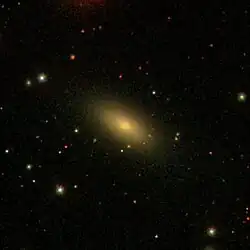| NGC 528 | |
|---|---|
 SDSS image of NGC 528 | |
| Observation data (J2000 epoch) | |
| Constellation | Andromeda |
| Right ascension | 01h 25m 33.60s[1] |
| Declination | +33° 40′ 18.0″[1] |
| Redshift | 4807 km/s[1] |
| Heliocentric radial velocity | 0.016034[1] |
| Distance | 233.53 ± 10.68 Mly (71.600 ± 3.274 Mpc)[1] |
| Apparent magnitude (B) | 13.7[2] |
| Characteristics | |
| Type | S0[1] |
| Apparent size (V) | 1.7′ × 1.1′[1] |
| Other designations | |
| NGC 528, UGC 988, MCG +05-04-057, PGC 5290[2] | |
NGC 528 is a lenticular galaxy located in the constellation Andromeda.[1] It is located an estimated 70 million parsecs from the Milky Way. The object was discovered on 22 August 1865 by the German-Danish astronomer Heinrich Ludwig d'Arrest.[3]
See also
References
- 1 2 3 4 5 6 7 8 "NED results for object NGC 0528". NASA/IPAC Extragalactic Database. National Aeronautics and Space Administration / Infrared Processing and Analysis Center. Retrieved 5 October 2018.
- 1 2 "NGC 528". SIMBAD. Centre de données astronomiques de Strasbourg. Retrieved 24 May 2018.
- ↑ "New General Catalog Objects: NGC 500 - 549". cseligman.com. Retrieved 2019-01-16.
External links
 Media related to NGC 528 at Wikimedia Commons
Media related to NGC 528 at Wikimedia Commons- NGC 528 on WikiSky: DSS2, SDSS, GALEX, IRAS, Hydrogen α, X-Ray, Astrophoto, Sky Map, Articles and images
This article is issued from Wikipedia. The text is licensed under Creative Commons - Attribution - Sharealike. Additional terms may apply for the media files.